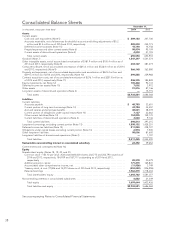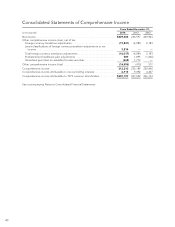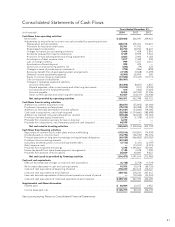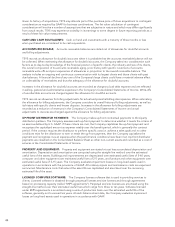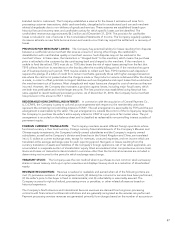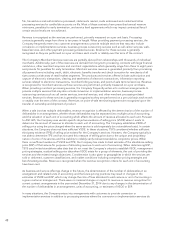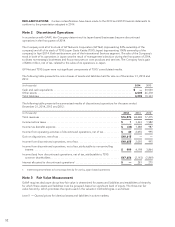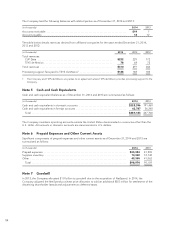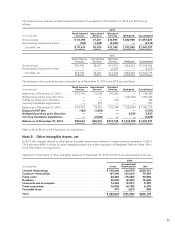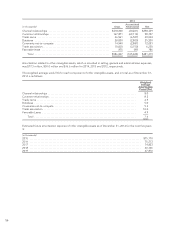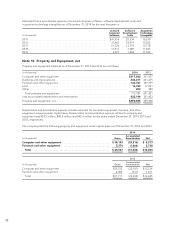NetSpend 2014 Annual Report Download - page 51
Download and view the complete annual report
Please find page 51 of the 2014 NetSpend annual report below. You can navigate through the pages in the report by either clicking on the pages listed below, or by using the keyword search tool below to find specific information within the annual report.file, transactions and authorizations processed, statements mailed, cards embossed and mailed and other
processing services for cardholder accounts on file. Most of these contracts have prescribed annual revenue
minimums, penalties for early termination, and service level agreements which may impact contractual fees if
certain service levels are not achieved.
Revenue is recognized as the services are performed, primarily measured on a per unit basis. Processing
contracts generally range from three to ten years in length. When providing payment processing services, the
Company frequently enters into customer arrangements to provide multiple services that may also include
conversion or implementation services, business process outsourcing services such as call center services, web-
based services, and other payment processing-related services. Revenue for these services is generally
recognized as they are performed on a per unit basis each month or ratably over the term of the contract.
The Company’s Merchant Services revenues are partially derived from relationships with thousands of individual
merchants. Additionally, part of the revenues are derived from long-term processing contracts with large financial
institutions, other merchant acquirers and merchant organizations which generally range from three to eight years
and provide for penalties for early termination. Merchant services revenue is generated primarily from processing
all payment forms including credit, debit, electronic benefits transfer and check truncation for merchants of all
sizes across a wide array of retail market segments. The products and services offered include authorization and
capture of electronic transactions, clearing and settlement of electronic transactions, information reporting
services related to electronic transactions, merchant billing services, and point-of-sale terminal services. Revenue
is recognized for merchant services as those services are performed, primarily measured on a per unit basis.
When providing merchant processing services, the Company frequently enters into customer arrangements to
provide multiple services that may also include conversion or implementation services, business process
outsourcing services such as call center services, terminal services, and other merchant processing-related
services. Revenue for these services is generally recognized as they are performed on a per unit basis each month
or ratably over the term of the contract. Revenues on point-of-sale terminal equipment are recognized upon the
transfer of ownership and shipment of product.
When a sale involves multiple deliverables, revenue recognition is affected by the determination of the number of
deliverables in an arrangement, whether those deliverables may be separated into multiple units of accounting,
and the valuation of each unit of accounting which affects the amount of revenue allocated to each unit. Pursuant
to ASC 605, the Company uses vendor-specific objective evidence of selling price (VSOE) when it exists to
determine the amount of revenue to allocate to each unit of accounting. The Company establishes VSOE of
selling price using the price charged when the same service is sold separately (on a standalone basis). In certain
situations, the Company does not have sufficient VSOE. In these situations, TSYS considered whether sufficient
third party evidence (TPE) of selling price existed for the Company’s services. However, the Company typically is
not able to determine TPE and has not used this measure of selling price due to the unique and proprietary
nature of some of its services and the inability to reliably verify relevant standalone competitor prices. When
there is insufficient evidence of VSOE and TPE, the Company has made its best estimate of the standalone selling
price (ESP) of that service for purposes of allocating revenue to each unit of accounting. When determining ESP,
TSYS uses limited standalone sales data that do not meet the Company’s criteria to establish VSOE, management
pricing strategies, residual selling price data when VSOE exists for a group of elements, the cost of providing the
services and the related margin objectives. Consideration is also given to geographies in which the services are
sold or delivered, customer classifications, and market conditions including competitor pricing strategies and
benchmarking studies. Revenue is recognized when the revenue recognition criteria for each unit of accounting
have been met.
As business and service offerings change in the future, the determination of the number of deliverables in an
arrangement and related units of accounting and the future pricing practices may result in changes in the
estimates of VSOE and ESP, which may change the ratio of fees allocated to each service or unit of accounting in
a given customer arrangement. There were no material changes or impact to revenue in revenue recognition for
current contract arrangements in the year ended December 31, 2014 due to any changes in the determination of
the number of deliverables in an arrangement, units of accounting, or estimates of VSOE or ESP.
In many situations, the Company enters into arrangements with customers to provide conversion or
implementation services in addition to processing services where the conversion or implementation services do
48


